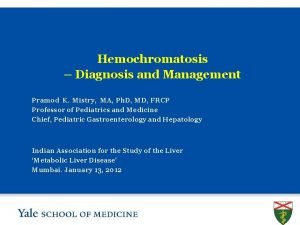POLYPHARMACY IN GERIATRIC PATIENTS Dr SHREYAS MISTRY MD

- Slides: 1

POLYPHARMACY IN GERIATRIC PATIENTS Dr SHREYAS MISTRY MD, Dr MAYUR RALI MD HOFSTRA-North Shore LIJ School of Medicine Department of Family Medicine Southside Hospital Family Medicine Residency Program Introduction List of Inappropriate Medications USA has 12. 9% population of persons 65 years and older consuming 36% of total healthcare expenditure. Rationale of using multiple medications, compliance, potential side effects, drug interactions, dose adjustments, multiple comorbidities, concurrent use of supplements are frequent challenges faced by physicians while treating this age group. There is compelling evidence demonstrating that many older adults are under-prescribed useful medications while on the other hand medications causing more harm than benefits are being prescribed. Objectives & Methods To review use of multiple medications in geriatric population & use of inappropriate medications using the Beer’s Criteria. We conducted retrospective analysis on patients from the outpatient clinic affiliated with Southside Hospital. Beer’s Criteria was used as a guideline for evaluation of medications (other medications not included in Beer’s Criteria, but with documented adverse effects in geriatric population, were also considered). Age, Sex, Number of medications, duration of treatment & number of inappropriate medications (medications with potential side effects, interactions, inappropriate dosing and medications listed in Beer’s Criteria) were considered during the study. Polypharmacy : 65. 8% of cases Results Review of 82 charts from the outpatient clinic revealed that polypharmacy was seen in 65. 8 % of the cases. 56 patients belonged to age group 65 -75 & 26 were 75 or more years. Out of these 31 were Male & 51 were Female. Out of total 511 medications taken by 82 patients, 100 were inappropriate (19. 5%); averaging 1. 21 inappropriate medications per patient. 67 of the 82 patients (81. 7%) were treated for the chronic conditions for 5 or more years. Good to fair compliance was found in 84% patients, 16% patients were poorly complaint in terms of medication usage and follow up visits with their Primary Physicians. From the 82 charts that were reviewed; duplication of medications, multiple medications from the same pharmacological class, inappropriate dosing of medications was not seen. It warrants more in depth analysis, as these criteria were not included in the core objective of the study. References • Using Medications Appropriately in Older Adults; Am Fam Physician 2002; 66: 1917 -24 • Minimizing Adverse Drug Events in Older Patients; Am Fam Physician 2007; 76: 1837 -44 • A Survey on Polypharmacy & Use of Inappropriate Medication in a Geriatric Out-Patient Clinic; J HK Geriatr Soc 1996; 7: 28 -31

